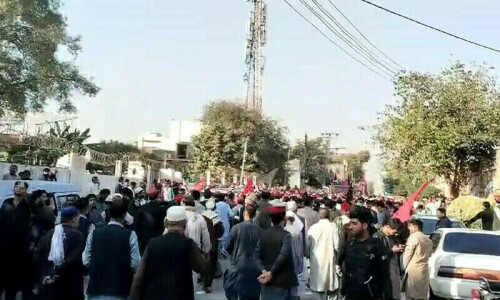 HYDERABAD, April 26: The chief engineer of the Kotri barrage, Mr Manzoor Sheikh, has presented a grim picture of water situation at the barrage. Speaking at his office on Wednesday, he said that available water was being supplied to off-taking canals to avoid water rotation.
HYDERABAD, April 26: The chief engineer of the Kotri barrage, Mr Manzoor Sheikh, has presented a grim picture of water situation at the barrage. Speaking at his office on Wednesday, he said that available water was being supplied to off-taking canals to avoid water rotation.
“As per the 1991 Water Accord, 6,900 cusecs of water is to be provided in the third 10-day period of April while at present only 2,770 cusecs of water is available at Kotri upstream and the shortage today amounts to 60 per cent”, he said.
He said that the total designed discharge of four off-taking canals of the barrage was estimated at 41,350 cusecs.
He said that in the third 10 daily for April, the withdrawal for canals increased to 3,210 cusecs (Keenjhar-Baghar feeder 1,150, Old Phulleli 850, New Phulleli 700 cusecs, Akram Wah 495 cusecs, Wadhoo Wah and Fasadi Wah 15 cusecs by depleting the pond and reducing shortage to 54 per cent.
He said that water which was being supplied to four canals was only for drinking purposes and at present more than 1,000 cusecs to Karachi metropolis for drinking purposes through the KB feeder.
He said that the shortage of water existed in the entire Indus river system which might be causing some problems given the fact that subsoil water in the entire command area of the barrage was brackish thus people and growers were dependent on the canal water.
He said that the situation would improve in the next one week as the Sindh irrigation minister was taking up the matter with authorities concerned.
He said that Keenjhar lake’s level stood at 47.55RL (reduced level) which was not ideal one but even then efforts were being made to utilise available water efficiently in the Thatta district.
He said that civic bodies had been directed to lift water carefully and rather improve their system, losses and water storage.
“Soon we will be out of woods”, said the chief engineer.
He said that water inflow at the Tarbela dam was also negligible while the water situation of the Kabul River was not satisfactory.
He said that at present KB feeder’s discharge stood at 1,000 cusecs, 500 of Akram Wah and 800 cusecs each of Phulleli and Pinyari canals.
He said that the question of rotation programme did not arise when there was not enough water in the system and we were managing existing ones by stopping water at regulators of canals so that water itself went into distributaries of canals.
Referring to the early Kharif season, Mr Shaikh said that the season begin in May and by then hopefully the situation would improve.
“Let us hope for the better ad water availability will be gradually improved”, he said.
He said that despite system losses were met through regenerated water when it was released from the Sukkur downstream.
About telemetry system, he said that it was still not working 100 perfectly and the company concerned was entrusted with the job.
He said that there was some design or software fault in the system which engineers were looking into.
In his written statement, he said that the situation at Guddu and Sukkur barrages had slightly improved and as a result discharge downstream Sukkur barrage had increased to 3,700 cusecs which would further be improved to around 5,000 cusecs in the next few days.
He said that it was anticipated that the situation would slightly improve at the Kotri barrage in the next six to seven days and with arrival of additional water at the Kotri upstream equitable distribution would be made to all four canals.
He urged civic bodies of Hyderabad, Thatta, Badin, Jamshoro and Tando Mohammad Khan districts to make necessary arrangements for the proper utilisation of available water in canals and eliminate any type of waste in their delivery systems.














































Dear visitor, the comments section is undergoing an overhaul and will return soon.